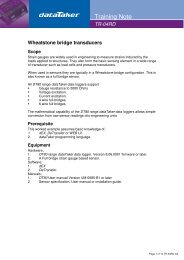Create successful ePaper yourself
Turn your PDF publications into a flip-book with our unique Google optimized e-Paper software.
Requested CAN data are not returned<br />
<br />
<br />
<br />
<br />
Use the STATUS command to check the status of the slot, and double check the slot definition parameters, as<br />
described above.<br />
Have you actually polled the slot? A common mistake is to simply enter a RQST command, which by itself will do<br />
nothing (unless the sample rate parameter is specified). Normally an RP command is required, which (for slot 0<br />
definitions) can be appended to the end of the request command eg.<br />
RQSTJ 2 61444; RP<br />
Try switching on the diagnostic message display using DIAG 3, then poll the request slot. You should see a CANx<br />
TX> message. Check whether there is any reply shown from the ECU – it is possible that the ECU does not<br />
implement this request.<br />
For J1939, it may be necessary to set the <strong>CANgate</strong>'s network address (default is 0) to a value that is unique on the<br />
network. Use the SETADDR command for this. Note that <strong>CANgate</strong> does not implement the network address<br />
management protocol described in SAE J1939/81.<br />
GPS data are not returned<br />
<br />
<br />
<br />
Use the STATUS command to check the status of the slot, and double check the slot definition parameters, as<br />
described above.<br />
Ensure that the GPS port baud rate (set using the GPSBAUD command) matches that of the GPS unit.<br />
Use SNOOP GPS to check the NMEA-0183 strings being sent by the GPS. If you don't see the string you want then<br />
you may need to send a command to the GPS (using GPSSEND) to enable it. Verify that the required data item within<br />
the string is present in the field number specified in the slot definition.<br />
Data Logger reports timeouts or scan errors<br />
In this case <strong>CANgate</strong> is connected to the serial sensor port on a DT80 series data logger.<br />
Check that the logger's serial sensor baud rate has been set to match that of <strong>CANgate</strong>, eg. PS=57600<br />
<br />
<br />
<br />
<br />
Check flow control settings – by default, <strong>CANgate</strong> uses hardware flow control, so the logger serial sensor port should<br />
also be set to hardware flow control, using PS=HWFC. If <strong>CANgate</strong> has been configured to use software flow control<br />
then the logger must be set likewise (PS=SWFC), otherwise the XON and XOFF characters may appear in the<br />
received data stream, which will probably disrupt the parsing of the returned data.<br />
With the logger in pass-through mode, verify that <strong>CANgate</strong> is configured for normal operation with no extraneous<br />
output (ie. VERBOSE OFF;DIAG 0).<br />
With the logger in pass-through mode, verify slot definitions using STATUS. <strong>Manual</strong>ly send some of the commands<br />
that the logger is sending in its 1SERIAL channel definitions and check that <strong>CANgate</strong> is returning data. Check that<br />
the format of the data matches that expected by the input conversion in the serial sensor control string (eg. if <strong>CANgate</strong><br />
is returning a floating point value then the serial sensor string should be set up to read a floating point value (%f) and<br />
not, for example, an integer (%d))<br />
Alternatively, enable diagnostic mode on the logger (P56=1), which will display data received on the serial sensor<br />
port in conjunction with the input conversions which are endeavouring to parse it. By examining these, it should be<br />
possible to determine why the input conversions are not working.<br />
<strong>CANgate</strong> repeatedly resets<br />
If <strong>CANgate</strong> detects a serious firmware problem then it will trigger a hardware reset. If this does not clear the problem then<br />
repeated resets may occur. If this is the case then to regain control it may be necessary to set the internal DIP switches to the<br />
Factory Defaults setting (see Configuration (P11)), and cycle the power.<br />
Error Messages<br />
If Verbose mode is selected, <strong>CANgate</strong> will return a descriptive message in the event that a problem is detected with any<br />
received command or operational situation. If verbose mode is switched off, no unsolicited messages will be returned;<br />
erroneous commands will be silently ignored.<br />
Syntax Errors<br />
If there is a problem with a command or parameter, a message is returned indicating where the error occurred. For example:<br />
Error: [ SWOOPJ 2 5000 ]<br />
In this case the problem is clear: a misspelt command; note that the tag immediately follows the problematic<br />
command or parameter.<br />
Error: [ 3 RECVJ 2 61444 ]<br />
Here the command name is OK but it is not valid in this context (eg. a slot number has been specified but <strong>CANgate</strong> is not in<br />
Program Mode, ie. BEGIN has not been seen.)<br />
Error: [ SNOOPJ ]<br />
In this case the tag is not attached to any particular parameter – so the problem here is a missing parameter<br />
(CANport).<br />
UM-0086-A2 <strong>CANgate</strong> User’s <strong>Manual</strong> Page 35



